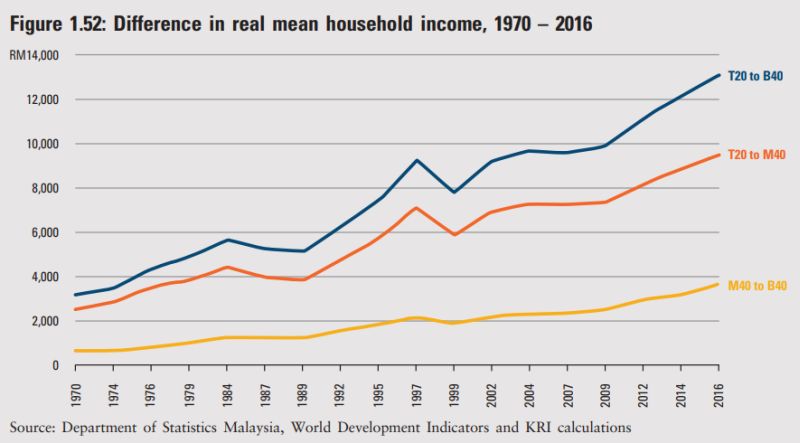KUALA LUMPUR, Oct 15 ― Ever wondered why you feel that the income divide between the rich and poor in Malaysia is getting wider and wider, despite the official index showing less inequality and a fairer distribution of income?
Khazanah Research Institute's (KRI) latest report shows that this disconnect between Malaysians' perceived reality and the official numbers is understandable and not without basis.
KRI noted that Malaysia's household income inequality measured using the Gini index has fallen from a high Gini coefficient of 0.513 in 1970 to 0.399 in 2016, which would suggest that income is being distributed more equally in the country.
But KRI said the public's typical view is that inequality is still a problem that has not been solved in the past few decades.
“The general perception is that the rich are getting richer, while the poor are getting poorer,” it said in its report titled “The State of Households 2018: Different Realities.”
KRI explained that this could be due to how income inequality is measured, namely whether household income is compared in relative terms or actual gap.
It gave the example where a high-income household with an income of RM10,000 doubles its income to RM20,000 in a year, while a low-income household experiences a faster income growth where its RM1,000 income triples to RM3,000.
In such a hypothetical scenario, relatively speaking, the inequality income index or Gini coefficient would have shrunk with the high-income household initially earning 10 times more than the low-income household in the first year, and subsequently earning only 6.7 times more.
But the absolute income gap between the two households of an initial RM9,000 would actually go up to RM17,000 in the next year, KRI said.
When it comes to Malaysia, income inequality among households can be measured between three income groups: the top 20 per cent (T20) or high-income group, the mid-income and low-income which take up the mid-tier 40 per cent (M40) and bottom 40 per cent (B40) respectively.
In relative terms according to a chart in KRI's report using the Department of Statistics Malaysia (DOSM) figures, a T20 household earned almost 10 times more than a B40 household in Malaysia in 1970, with this multiple falling to almost six times in 2016.
The multiple between income for the T20 households and M40 households, as well as the multiple between M40 and B40 households similarly decreased during the same period, the chart showed.
“However, the absolute gap between all three income groups has increased, the gap between the top 20 per cent and bottom 40 per cent is particularly striking, and this could be the reason for resentment and the negative perception of inequality,” KRI explained.
In a separate chart, the actual income gap between T20 and B40 households actually increased from less than RM4,000 (1970) to more than RM12,000 (2016).
The income gap in actual terms between T20 and M40 households also went up from over RM2,000 to less than RM10,000 during the same period, while the M40 and B40 actual gap in real mean household income also rose.
According to a factsheet provided by KRI, the actual income gap between the T20 households and both the M40 and B40 households had “almost doubled” compared to two decades ago.

Poverty rate down, but one million more poor households in decade
KRI also highlighted how more people could in fact be poor, even when the poverty rate in a country has gone down.
KRI's report included a chart which showed the poverty rate in Malaysia going down from 1995 to 2016, illustrated by the decline in percentage from about 45 per cent of Malaysian households in the B40 group in 1995 falling to just slightly above 43 per cent in 2016.
But it said the number of poor households in Malaysia has actually increased due to population growth, KRI said.
“More than a million households live in 'relative poverty' compared to two decades ago,” it said in a factsheet, pointing to the additional number of households that are in the B40 group as of 2016 and since 1995.
From slightly below two million B40 households in 1995, it has now increased to about three million B40 households as of 2016, the chart using figures from DOSM and the Economic Planning Unit and KRI's own calculations show.
As of 2016, there are 6.9 million Malaysian households.
KRI noted that the existence of falling inequality is insufficient to reassure the public as inequality still exists.
“The growing number of poor households is clearly quite visible to the public, thus fuelling the negative sentiment surrounding inequality,” it said.
KRI also indicated that efforts to have measures based on more refined data should be continued to assist in the understanding of pressing economical issues and the identification of the necessary steps to address them.



















